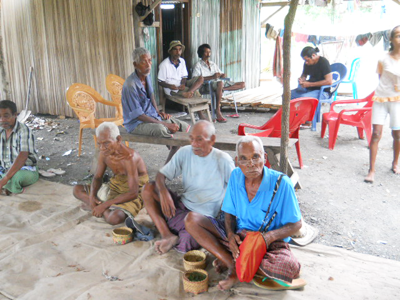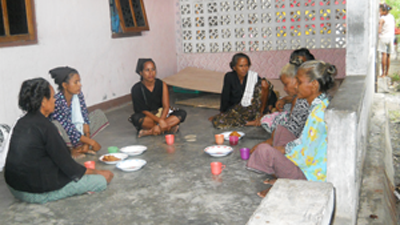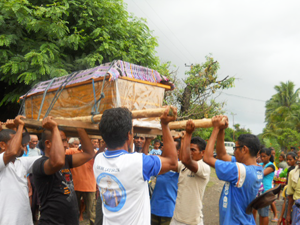Hader Mate - Hakoi Mate (Death Ritual of Fehan-Tetun People in Suai, East Timor
Ita ema sei moris halo rain naran. Mate tia rai taka tilun la rona. When we live, we do great things on earth. When we die, you are covered in earth and you can not hear any more.

The people of Fehan-Tetun believe that when you die, your klamar (soul) leaves the body and moves to a different spiritual or invisible world. Hence, you no longer live in the material world—the one you can see and feel. Your klamar (soul) will live in an intangible world that is untouchable. To lead the soul into this unknown world, they celebrate the corpse with ceremonial rituals and bury the body in the family or public cemetery.
The inhabitants of Fehan-Tetun practice two kinds of death rituals. They are the Hader Mate or Hakoi Mate (morning rituals and burial of the dead) and the Mutun Mate (the ultimate resting ritual). The latter will occur three years from the burial date, while the former is only for planning funeral services.
When a family member dies, they keep the body in the family's traditional or brick House. Temporarily, they call this House Uma Mate (the death house), where all relatives and the neighbourhood will come together to mourn and honour the deceased. The body is dressed in customary tais and placed on a mat or in a casket after being cleansed.

Because the House of the Dead does not have sufficient space to accommodate many people, they have to build a temporary tent in front of the House -- they call it Laleo. The traditional leaders from all Uma Lulik and other prominent community leaders will be seated on a traditional carpet called Biti on the ground under the tent. Traditionally, you're not allowed to sit on Western chairs.
On the first night, all the traditional leaders of Uma Lulik and Uma Fukun will invite the entire community to visit Uma Mate (the Death House). This unique gathering is called Tur Motu (meeting). The elders will discuss memorial services and issue invitations to the community (Katak Ema, "Invite People). They will send a group of youth to invite all households within the community. These groups of young men and women will knock on each House's door to invite all young and older people to come to mourn, honour, and pay their respects to the deceased. The next day, the entire neighbourhood came to the House of the Dead to sympathize with and support the family. The young women will prepare and make the floral arrangements, while the young men will dig the grave and build the coffin if they do not have a custom-made coffin.
The death house will be full of young and older people for at least two nights. The dead's relatives and other community members do a special mourning ritual called Tanis Mate (Dead Weeping). Both men and women will take turns doing this unique ritual. They express their sorrow and sadness by telling the story of the dead person—how they used to do things in the family and the community. In addition, some people perform traditional songs and play cards to keep them awake. Also, a group will recite prayers every two or three hours if you are Christian.
During the mourning rituals, the family of the dead must provide some food for the mourners, such as bread, coffee, tea, rice, and meat. In the past, they usually had a big celebration by slaughtering cows and pigs to feed the mourners, but now they do not do it anymore. They only slaughter cows and pigs for Mutun Mate (the ultimate resting ritual).

It is a tradition of the Fehan-Tetun people that when you go to Uma Mate (the House of Death), you should bring cash to help the deceased family. Some women contribute money and traditional Timorese textiles (tais). These voluntary contributions will assist the deceased family in recovering the cost of their expenditures.
People made coffins from coconut palms in the past, but now some people buy custom-made coffins from a craftsman. The coffin looks more modern than traditional coffins. Even the tomb has undergone some modifications. Before, people did not put cement in the tomb, but now the cement is placed in the tomb from bottom to top. You no longer have to cover the tomb with earth.
After two nights of mourning, it is time to bury the dead. When the coffin is ready, the corpse will be put in the uncovered coffin for families and guests to see. Then they cover and decorate the coffin with tais (traditional clothes), black cloth, and some strings. The coffin containing the corpse is now ready to be taken to the place of the funeral. A group of strong young men will carry the casket, accompanied by people in mourning. In the past, people were not Christians, so there were no crosses or prayers, but now some people have been converted to Christianity, so the cross leads the funeral procession, and mourners recite prayers during the procession.
There will be three more nights of mourning following the burial before pouring concrete on the grave and putting flowers in it. It is an exceptional night for young men and young women to make tattoos and meet new friends. They construct the tomb from concrete, plaster, and ceramic tile as the finishing touch. You can discuss with the carpenter how you want the grave to be built. Some people built it to resemble a little house where you can place the deceased's portrait inside.
After three nights of grieving, the tomb is finally prepared, and the relatives may bring flowers to the cemetery. This ceremony is only for the relatives of the deceased. After this, they will have another celebration called Mutun Mate (the ultimate ritual), which will take place in three years.
